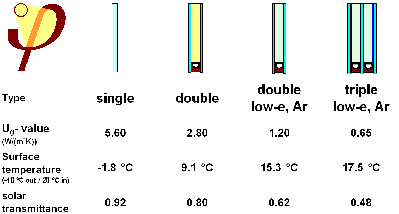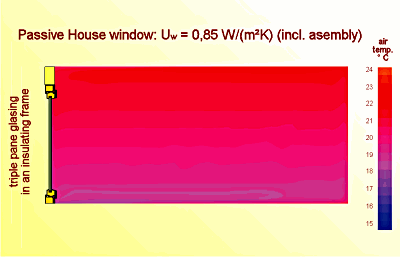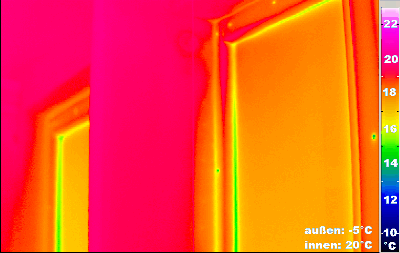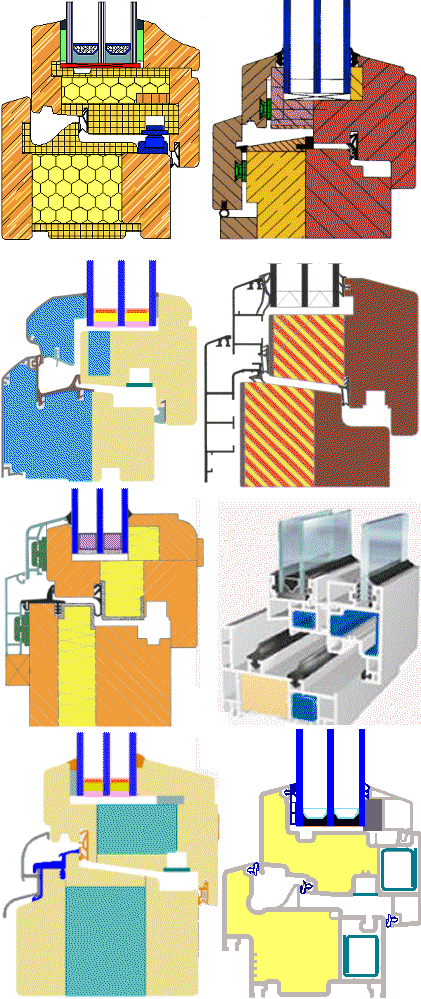| |
Windows
for Passive Houses |
|

Glazings suitable for Passive Houses (right hand side) will have comfortable
interior surface temperatures even in conditions with heavy frost.

No temperature stack will be perceivable if a Passive House window is
used. Therefore the radiator can be placed at interior walls as well
and still the optimal thermal comfort according to ASHRAE-55 comfort class
"A" will be met.

This is an infrared shot of the interior surface of a passive House window
(outdoor air temp. -5°C, indoor 20°C). The whole surface is comfortably
warm: All parts of the frame and the glazing. Even at the glazing rebate
the surface temperature does not fall short of 15 °C (Picture: PHI).

For comparison, an old double pane window under the same conditions. Already
the average temperature is below 14°C. But severe thermal bridges
can be seen, especially near the concrete lintel (Picture: PHI)

Double-pane low-e glazings (in a newly assembled window door) show a somewhat
higher surface temperature (16 °C in average). The poor insulation
of the conventional frame is eye-catching. Passive House frames allow
for a significant improvement.

Examples of windows suitable for Passive Houses using insulating frames.
These and others will be shown at the exhibition during the conference
on Passive Houses.
There is no other component
in the building sector with as rapid development in quality than in the
field of windows. The thermal loss coefficient of windows on the market
(Uw-value) has been reduced by a factor 8 during the last 30 years.
At the beginning of the 1970s most windows in Germany had single glazing,
the Uw-value was some 5.5 W/(m²K) (approx. R = 1 ft2h°F/Btu
in imperial units). The heat losses through 1 m2 of such a
window added up to some 60 liters of heating oil (0.35 barrel per 10 ft2
and year). Such a window causes running costs of some 48 /m2 for final
energy for heating each year, calculating with the energy costs of the
future in Europe (some $40 per 10 ft² annually).
But not only are the energy losses high. Because of the poor insulation,
the external coldness can penetrate through the window directly to the
inside surface: If the outdoor air temperature is below -7.5°C (18.5°F),
there will be frost on the interior surface, well known as "frost
pattern". A poor insulation therefore is related with minimum comfort
and increased danger of damages.
Somewhat better is the performance of the so called "thermopane glazings"
or double glazings, which have been introduced in new constructions and
retrofits in Germany after the first oil price crisis. There is an air
gap enclosed between two panes. The heat loss coefficient is reduced to
some 2.8 W/(m²K) (R = 2 ft²h°F/Btu in imperial units). The
consequence: Almost half of the losses are saved compared to single glazing
and that is half of the annual costs. The interior surface temperature
will not be lower than 7.5 °C (45.5°F) even during extraordinary
cold periods (-15°C or 5°F). There will not be any frost pattern
but the surface is still uncomfortably cold and will show condensation,
because the temperature is far lower than the dew point.
The introduction of razor-thin metal coatings inside the interpane space
was the most important success - called "low-e"-layer for the
low thermal emissivity. These coatings reduce the thermal radiation between
the inner and the outer pane by a factor of 5 to 20. Even more, the gas
in the gap is changed from air to noble gasses (Argon or Krypton), which
have a far lower heat conductivity. These so called "low-e-glazings"
became almost standard construction throughout Germany after the German
new "Wärmeschutzverordnung" (Ordinance on Insulation) of
the year 1995. It is interesting, that glazings did not become more expensive,
in spite of the much increased quality. A commonly used wooden or plastics
window using a standard spacer and a standard double pane low-e glazing
has a Uvalue between 1.3 and 1.7 W/(m²K) (R = 3.3 to 4.4 ft²h°F/Btu
in imperial units). Thus the heat loss reduced another time by a factor
of two compared to the old double pane window. Now the average interior
surface temperature will be some 13°C (55.4°F) during heavy frost
periods. But still the cold air flow from the window (through convective
currents) can be perceived as an uncomfortable cold air layer at the floor,
and this problem must be resolved for optimum comfort. (In this regard,
thermal comfort is discussed within typical Central European climate.
In different climates the interior surface temperatures should be the
same to give the same comfort level, but the required U-values will be
different).
The breakthrough for energy efficient construction in Germany was the
availability of triple-pane low-e glazing. If one adds two gaps between
panes with one low-e-coating in each gap and noble gas filling, U-values
between 0.5 and 0.8 W/(m²K) result (R = 7.1 to 11.4 ft²h°F/Btu
in imperial units). This requires that not only the glazing, but the whole
window should have such a quality, including an insulating window frame
and insulating spacers. The result is a "thermal comfort window"
or a "Passive House window". Using such a window, the annual
heat loss is reduced to not more than 8 liters heating oil by each square
meter of window area (0.05 barrel oil per 10 ft² of window area)
that is a factor eight compared to the initial value. If one considers
the passive solar energy gained through the window in addition, in a Central
European climate the losses of a window of this quality are significantly
outweighed by gains. It is not by chance that the net heat losses of transparent
components of the building envelope are negligible as are the heat losses
of opaque parts (walls and roofs). The level of insulation of the opaque
envelope (U-values of some 0.15 W/(m²K) is well matched to the quality
of the windows suitable for passive houses. Both together allow Passive
Houses to be built in the wet-cold winter climate in Central Europe, which
will maintain thermal comfort just by heating the fresh air from the ventilation
system.
But the advantages of the Passive House window are not only reduced heat
losses, but also increased thermal comfort. Even during heavy frost periods,
the interior surface temperature will not fall below 17°C (62.6°F).
The consequence is that no "cold radiation" can be perceived
from such a window nor is an uncomfortable cold air layer possible if
no radiator exists near the window. Of course, all the other conditions
for Passive Houses have to be met too, e.g. air tightness and a construction
free of thermal bridges. With these conditions the thermal comfort will
be independent of the way the heat is transferred to the room. To be able
to do so, the improved windows are a key feature.
At the exhibition of the 10th Conference on Passive Houses all the important
components of a high quality window can be seen and touched:
- Triple-pane, double-low-e glazings.
- Insulated wooden frames,
- Insulated plastics frames,
- Insulated glas facade constructions,
- Insulating spacers,
- Components for thermal-bridge free and air tight windows.
There is no other component in the building sector with a comparable fast development to improved quality than in field of windows. The thermal loss coefficient of windows on the market (Uw-value) has been reduced by a factor 8 during the last 30 years.
(updated: 2006-09-23 WF thanks to Dylan Lamar for proof reading
© Passive House Institute; unchanged copy is permitted, please give reference to this page)